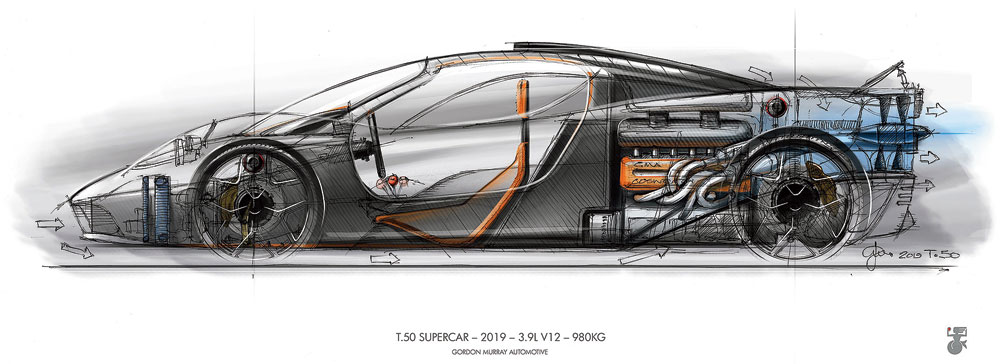Now seems to be a time when a lot of car designs that were driven by technology are breaking down. What do you think upcoming cars will look like?
As far as regular (as opposed to supercars) cars go, I think two revolutions are coming which would drive different design.
The first one is powertrain because with hybrid and electric power the packaging is completely different. All car design, styling if you like, is driven by packaging. And when you have a different powertrain, it allows you to have a completely different architecture. So you have more opportunities and more problems with the styling.
For example, an electric car needs less cooling than an internal combustion car. So the radiator position might be different. That’s the good side. The bad side is that you have to package two-, three-, four hundred kilograms of battery. If you look at Tesla, for instance, it raises the floor because the battery is underneath the occupants and then it becomes much more difficult to make a car that is sleek or low or sporty. So, the first thing that will change car design is the technology change for powertrains.
The second change will be much bigger — autonomous vehicles. Once we get them, there will be slow evolution. They will not really be cars any more. So you won’t have a steering wheel or pedals and visibility will no longer be important. Visibility would be entertainment rather than control. We (at Gordon Murray Design) are designing our first autonomous vehicle now and they are called Pods because they don’t really have to look like a car any more.
So, the thing can look like nothing like a car. You will see a revolution in the next 20 years of what cars, or vehicles, will look like.

The McLaren F1, in which, uniquely, the driver sat in the middle and which used gold leaf to dissipate heat, looks as futuristic today as it did when it was made back in 1991 Picture: McLaren Automotive
If cars don’t look anything like what we’ve seen so far, how would the aesthetics of car design change?
If you look at design in general, whether it is architecture or civil engineering (like bridges), all those things are driven by function. When you design a building like this (Rambagh Palace, Jaipur) it could have been four square flat sides with windows and doors. But it isn’t because there was a cultural influence and a feeling of design and importance. That’s why this building looks like it looks. I don’t think it ever goes away. You could make a bridge look really ugly and it would still work. Or you can make a bridge look beautiful and it still works. And I think that will be the same with vehicles.
Just because you don’t have to have the doors in the same place, the engine in the same place, you could be facing backwards, and you could be facing sideways, you could be in the pod with eight other people, just because you have those completely different influences in the architecture doesn’t mean to say that you can’t make the thing look good. This little pod that we are doing doesn’t look anything like a car but it’s still a pretty design.

This week, Murray has shown the design of his T.50, which aims to set the standards in lightweighting and aerodynamics for supercars once more Picture: Gordon Murray Design
It’s often difficult for people to buy something that they cannot relate to. So it’s difficult for design to make a clean break. How do you think that will work for cars?
That is true, but that is purely habit. Look at the square cars from the 1930s. If you made a car like that today, nobody would buy it. They expect a car to look aerodynamic. They expect a car to look slightly sexy and modernistic if you like. So that’s a slow change. If we fast forward 25 years, and if you try to sell a car with a grille in front, people would say that kind of old-fashioned. Why do I need a grille if there is no radiator?
The other thing that we will see is a complete ownership model change with younger people. If you take people under 30 in the UK, for example, fewer and fewer actually want to own a car — and they don’t. The whole model is changing. There will be much more of the Uber and Lyft type of service, cars that you can pick up and drop at depots. Over time, the older generation, people who are attached to a particular look of a motor car or a brand, will all be gone. So the passion that my generation had with noise and shape and brand — that stuff will die.
How do you see the hydrogen fuel cell vs battery electric battle?
Battery technology is winning because it’s easy. And we can charge batteries now with current technology. But it’s an unbelievably inefficient mechanism because we have to carry so much weight. For the Tesla, for instance, half its weight is its batteries. Internal combustion engines will be around for a long, long time alongside new technologies.










